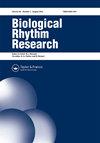Twenty-four-hour and nocturnal ambulatory blood pressure variability patterns in diabetics and hypothyroid patients: Looking through different temporal windows
IF 0.9
4区 生物学
Q3 BIOLOGY
引用次数: 0
Abstract
ABSTRACT This cross-sectional study attempted to determine the 24-h blood pressure variability (BPV) and nocturnal dipping, through designated temporal windows in diabetic and hypothyroid patients. BPV profiles were examined in the cohorts of 26 diabetics and 27 hypothyroid patients on their prescribed medications. Fifty-seven (57) healthy normotensive subjects were treated as controls. We recorded blood pressure (BP)parameters in each subject over at least two to three consecutive days, using an ambulatory blood pressure monitor (ABPM). We analyzed the data employing A&D software, Cosinor rhythmometry, and SPSS software. Most of the patients displayed a statistically significant circadian rhythm with prominent periodsat 24 h and/or 12 h. The hourly-averaged data in patients exceeded the normal range of BP during the early morning and late afternoon. BP parameters in studied patients were significantly higher than in the controls. The results depicted significant and independent effects of “temporal window” and “disease” on the nocturnal BP profile. Higher BPV and bouts of nocturnal hypotension in diabetic and hypothyroid patients indicate poor BP management. The diagnosis of BP and efficacy of treatment in diabetic and hypothyroid patients could be detected proficiently by ambulatory BP monitoring. Temporal window analysis could be beneficial for tracing nocturnal dipping precisely.糖尿病和甲状腺功能减退患者24小时和夜间动态血压变异模式:通过不同的时间窗观察
摘要这项横断面研究试图通过指定的时间窗来确定糖尿病和甲状腺功能减退患者的24小时血压变异性(BPV)和夜间血压下降。研究了26名糖尿病患者和27名服用处方药的甲状腺功能减退患者的BPV谱。五十七(57)名血压正常的健康受试者作为对照。我们使用动态血压监测仪(ABPM)记录了每个受试者至少连续两到三天的血压(BP)参数。我们使用A&D软件、Cosinor韵律测量法和SPSS软件对数据进行分析。大多数患者在24小时和/或12小时表现出具有统计学意义的昼夜节律,周期突出。患者的每小时平均数据在清晨和下午晚些时候超过了血压的正常范围。研究患者的血压参数明显高于对照组。研究结果显示,“时间窗”和“疾病”对夜间血压的影响显著且独立。糖尿病和甲状腺功能减退患者的血压升高和夜间低血压发作表明血压管理不善。动态血压监测可以熟练地检测糖尿病和甲状腺功能减退患者的血压诊断和治疗效果。时间窗口分析可能有助于准确追踪夜间倾斜。
本文章由计算机程序翻译,如有差异,请以英文原文为准。
求助全文
约1分钟内获得全文
求助全文
来源期刊

Biological Rhythm Research
生物-生理学
CiteScore
3.00
自引率
9.10%
发文量
34
审稿时长
6-12 weeks
期刊介绍:
The principal aim of Biological Rhythm Research is to cover any aspect of research into the broad topic of biological rhythms. The area covered can range from studies at the genetic or molecular level to those of behavioural or clinical topics. It can also include ultradian, circadian, infradian or annual rhythms. In this way, the Editorial Board tries to stimulate interdisciplinary rhythm research. Such an aim reflects not only the similarity of the methods used in different fields of chronobiology, but also the fact that many influences that exert controlling or masking effects are common. Amongst the controlling factors, attention is paid to the effects of climate change on living organisms. So, papers dealing with biometeorological aspects can also be submitted.
The Journal publishes original scientific research papers, review papers, short notes on research in progress, book reviews and summaries of activities, symposia and congresses of national and international organizations dealing with rhythmic phenomena.
 求助内容:
求助内容: 应助结果提醒方式:
应助结果提醒方式:


